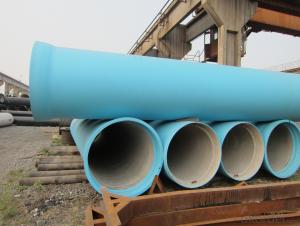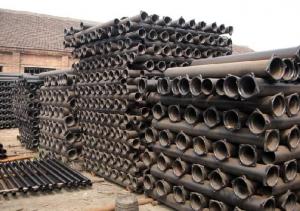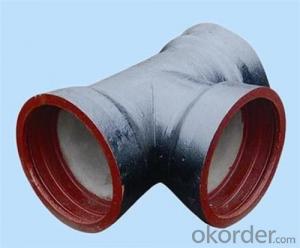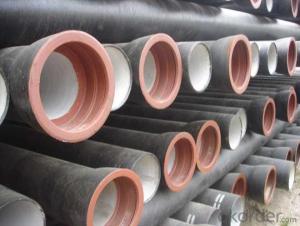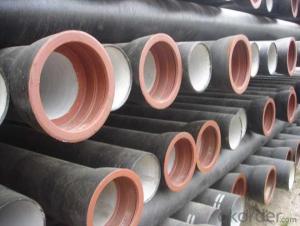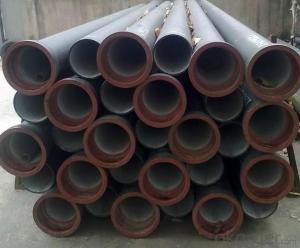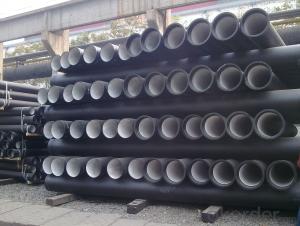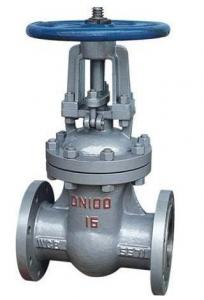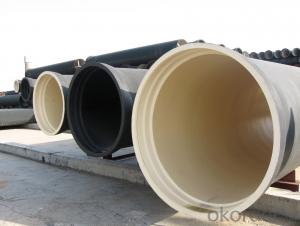Ductile Iron Pipe of China DN200 EN545 High Quality
- Loading Port:
- China main port
- Payment Terms:
- TT or LC
- Min Order Qty:
- 22 m.t.
- Supply Capability:
- 200000 m.t./month
OKorder Service Pledge
OKorder Financial Service
You Might Also Like
1,Ductile Iron Pipe Description :
1) Pipes confirm to ISO2531,K9 class,T type joint,6m long,with inside cements lining conform to ISO4179, outside Zinc spraying(130g/m2) and bitumen coating(70μm) conform to ISO8179.
2) Pipe ends: Spigot and socket ends, with 100% SBR rubber gaskets accoding to ISO4633
3) we can do third party inspection according to customer's request.
4) Our products have been sold to many international market, such as Middle East and South East Asia and Africa.
2,Main Features of the Ductile Iron Pipe:
•High yield strength
•High tensile Strength
•High corrosion resistance
•Pressure Resistence
•Anti-corrosion
•Installation is convenient
•Satisfy the highest hygienic standards
Length: 6m or cut into 5.6m, 5.7m, 5.8m
Internal Lining: Cement, conform to ISO4179
External coating: Zinc + Bitumen, conform to ISO8179
Rubber: NBR, SBR, EPDM according to ISO4633 / EN681.1
Note: The gaskets, bolts & nuts are supplied respectively as your special requirement
3,Ductile Iron Pipe Images:
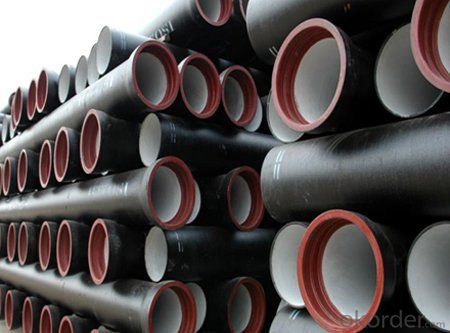
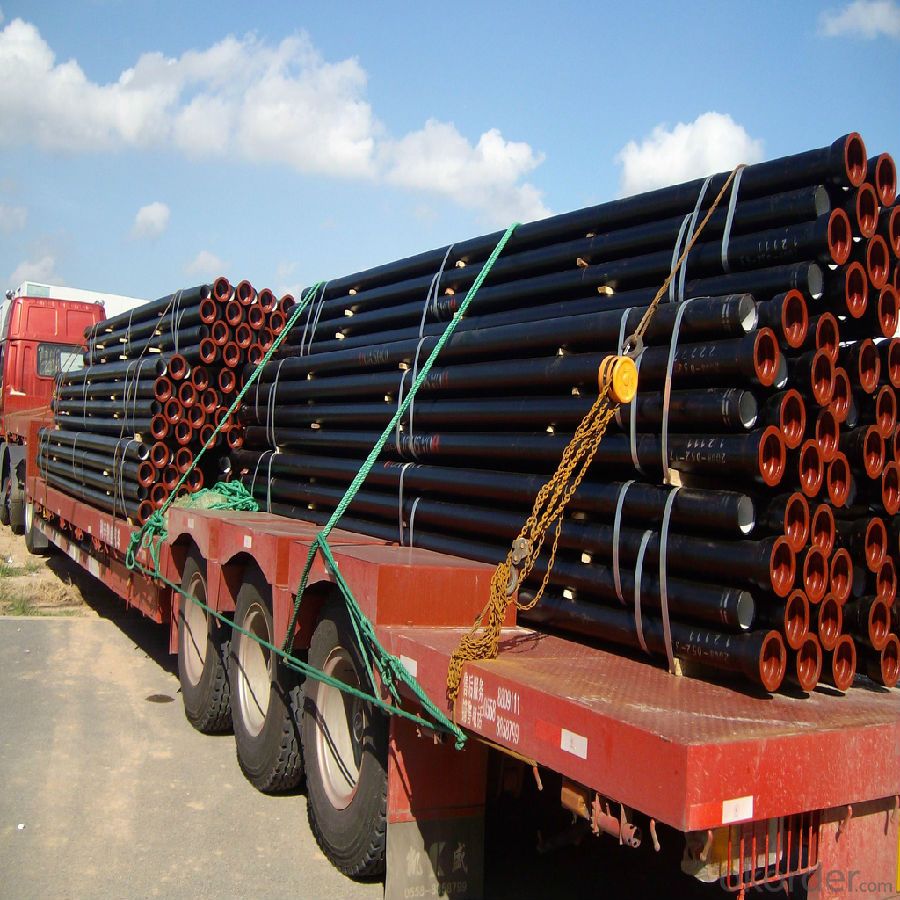
4. Ductile Iron Pipe Specification:
Processing service: Beveling, Threading, Slotting, Cut-to length, Bends, Quench and Temper, Fabrication, Double-jointing and On-site assistance
Documentary: MTC, material certification,Origin certification, CI or PI,Test Report, export licence, handling order, B/L,insurance policy,shipping instructions, contract, packing list etc.
Internal lining: ductile iron pipes shall have an internal cement mortar lining in acc with ISO4179.
External coating: ductile iron pipes shall be externally coated with metallic zinc spray plus a further layer of resin painting to ISO8179.
Gasket: 100% SBR/NBR/EPDM rubber gasket in accordance with ISO4633.
Packing: ductile iron pipes from DN100 to DN300 be bundled with steel belts, others are in bulk.
Payment term: L/C, T/T.
Packing: In bulk vessel or in container
5.FAQ:
We have organized several common questions for our clients,may help you sincerely:
1.Q: Why would you choose ductile iron pipe rather than other pipe materials?
A:The reasons are obvious for that not only ductile iron pipe possesses the inherent strength and flexibility of ductile iron, combined with proven corrosion protection systems, but also the cost savings can be achieved from design to installation and commissioning.
2.Q:Why can you guarantee the inner of pipes can’t be corroded?
A: High alumina cement mortar lining and sulphate-resistant cement mortar lining. These two special linings are applicable to inner anti-corrosion for sewage pipes, improving resistance to erosion of the sewage components.
- Q: What are the different methods for joining ductile iron pipe?
- There exists a variety of methods to join ductile iron pipe, each possessing its own advantages and limitations. One commonly utilized technique is the mechanical joint (MJ) coupling, where a rubber gasket, bolts, and nuts are employed to establish a watertight seal between pipe sections. This method is comparatively swift and straightforward to install, although it necessitates the expertise of a skilled technician to ensure proper alignment and bolt tightening to prevent leakage. Another approach is the flanged joint, which involves equipping the pipe ends with flanges that are fastened together using gaskets to form a secure seal. This method permits easy disassembly and reassembly of pipe sections, making it suitable for applications requiring frequent maintenance or alterations. However, it is more costly and time-consuming when compared to other methods. A widely employed method is the push-on joint (POJ), wherein a rubber gasket and a special lubricant are utilized to slide the pipe ends together. This technique yields a reliable and watertight seal, and installation is relatively rapid and simple. However, it necessitates proper alignment and cautiousness to prevent damage to the gasket during assembly. An alternative option is the restrained joint (RJ), which utilizes a mechanical joint coupling with additional features to resist axial forces or thrusts. This method is commonly employed in applications where the pipe is subjected to internal pressure, external loads, or seismic activity. It offers a secure and rigid connection but may require specialized tools and training for installation. Lastly, welding is another method for joining ductile iron pipe. This involves heating the pipe ends and melting a filler metal to create a permanent bond. Welding provides a strong and durable connection, but it demands skilled welders and additional time for preparation, welding, and cooling. It is often employed for specific applications, such as joining sections of pipe with different diameters or connecting to other materials. In conclusion, the various methods for joining ductile iron pipe encompass mechanical joint coupling, flanged joint, push-on joint, restrained joint, and welding. The selection of the method relies on factors such as application requirements, installation time, maintenance needs, and budget.
- Q: Are ductile iron pipes suitable for use in irrigation gate systems?
- Yes, ductile iron pipes are suitable for use in irrigation gate systems. Ductile iron is a type of cast iron that has enhanced strength and flexibility, making it a durable and reliable choice for applications such as irrigation gate systems. Ductile iron pipes are known for their high tensile strength and resistance to corrosion, which is important for maintaining the integrity of the irrigation system. Additionally, ductile iron pipes have the ability to withstand high pressure and provide a long service life, making them a cost-effective solution for irrigation gate systems. Overall, ductile iron pipes are well-suited for use in irrigation gate systems due to their strength, durability, and resistance to corrosion.
- Q: Can ductile iron pipes be used in acidic environments?
- Yes, ductile iron pipes can be used in acidic environments. Ductile iron has excellent resistance to corrosion, including acidic conditions, due to its protective oxide layer. This makes it a suitable choice for applications in which exposure to acids is expected.
- Q: What are the different joint types available for ductile iron pipe?
- Ductile iron pipes offer a range of joint types, each with its own benefits and uses. The most commonly employed joint types in ductile iron pipe installations include: 1. Push-on Joint: This type involves inserting a rubber gasket into a groove on the pipe's spigot end. The pipe is then pushed into the bell end of the adjacent pipe, creating a watertight seal. Push-on joints are known for their quick and easy installation, making them perfect for applications that require efficiency. 2. Mechanical Joint: This joint relies on a gland and follower gasket, which are compressed between the spigot end of one pipe and the bell end of another. Bolts and nuts are used to secure the joint, ensuring a tight and secure connection. Mechanical joints provide excellent integrity and are used in applications with higher pressures or heavy loads. 3. Flanged Joint: Flanged joints utilize flanges on the pipe ends, which are bolted together with gaskets to achieve a leak-proof connection. These joints are commonly employed in situations where pipes need to be easily disconnected and reconnected, such as pump stations or valve connections. 4. Restrained Joint: These joints are specifically designed to prevent pipes from separating under high internal pressures or external forces. They typically incorporate mechanical joints with additional restraining devices like harnesses, rods, or thrust blocks. Restrained joints are commonly used in applications where pipe movement poses a risk or stability is crucial. It is important to consider factors like the application, operating conditions, and project requirements when selecting a joint type. Consulting a professional engineer or pipe manufacturer is advisable to ensure the most suitable joint type is chosen for a specific ductile iron pipe installation.
- Q: What is the expected thrust restraint method for ductile iron pipes?
- Typically, to achieve the expected thrust restraint for ductile iron pipes, mechanical joint restraints are employed. These restraints are designed to counteract the axial forces or thrust caused by the fluid pressure within the pipe. Thrust blocks, tie rods, and harness restraints are the most commonly used types of mechanical joint restraints for ductile iron pipes. Thrust blocks are concrete structures strategically placed around the pipe joints to resist the thrust forces. They are typically constructed at bends, tees, and other directional changes to prevent pipe movement. Tie rods, on the other hand, are another frequently used method of thrust restraint. These involve steel rods that are anchored to the pipe and securely fastened to an immovable structure to counter the thrust forces. Harness restraints, however, are constituted by a series of steel rods or cables that encircle the pipe and are anchored to the ground on both sides. These restraints effectively distribute the axial forces along the pipe's length, preventing movement and ensuring stability. The choice of a specific thrust restraint method for ductile iron pipes may vary depending on various factors such as pipe diameter, fluid pressure, soil conditions, and local regulations. It is vital to consult industry standards, engineering guidelines, and local authorities to determine the appropriate thrust restraint method for a particular application.
- Q: How does ductile iron pipe perform in sandy or unstable soils?
- Due to its inherent strength and flexibility, ductile iron pipe exhibits exceptional performance in sandy or unstable soils. Its composition, which includes a combination of iron, carbon, and small amounts of other elements, grants it superior mechanical properties compared to other pipe types. In sandy soils, where the ground may shift and cause pipe movement and deformation, ductile iron's high tensile strength and elongation characteristics enable it to withstand pressure and stress without fracturing or breaking. Its flexibility allows it to accommodate soil movement and settlement, reducing the risk of pipe failure. Furthermore, ductile iron pipe's resistance to corrosion makes it highly suitable for installation in sandy soils. The application of protective linings and coatings on both the interior and exterior of the pipe prevents corrosive elements in the soil from attacking the iron, ensuring durability and reliability in the long term. In unstable soils with varying compaction levels or weak load-bearing capacity, ductile iron pipe's sturdy construction provides stability and support. Its robustness allows for even distribution of loads, minimizing the chances of pipe deflection or collapse. Moreover, the joint design and sealing methods of ductile iron pipe, such as push-on joints or mechanical joints with rubber gaskets, offer excellent leak resistance and prevent soil infiltration. This further enhances its performance in sandy or unstable soils. Overall, the combination of strength, flexibility, corrosion resistance, and reliable joint systems makes ductile iron pipe an ideal choice for applications in sandy or unstable soils. It provides a long-lasting and efficient solution for the transmission of water and wastewater.
- Q: Are ductile iron pipes suitable for use in agricultural applications?
- Yes, ductile iron pipes are suitable for use in agricultural applications. They are known for their durability, strength, and resistance to corrosion, making them ideal for transporting water, sewage, and irrigation systems commonly found in agriculture. Additionally, ductile iron pipes have a long lifespan and can withstand high pressure, making them a reliable choice for agricultural applications.
- Q: Can ductile iron pipes be used for high-pressure applications?
- Yes, ductile iron pipes can be used for high-pressure applications. Ductile iron has excellent strength and durability, making it suitable for handling high-pressure conditions. Additionally, ductile iron pipes have a higher pressure rating compared to other materials, making them a reliable choice for high-pressure applications.
- Q: How can the steel plastic composite pipe be connected with the cast iron pipe?
- The hoop has the advantages of beautiful appearance, convenient operation, strong clamping force, good sealing performance, etc.. Mainly used for connecting and fastening vehicle, ship, diesel engine, gasoline engine, machine tools, fire, and other machinery and equipment, chemical equipment general nylon hose, plastic hose, hose cloth, water interface and seal etc..
- Q: Can ductile iron pipes be used for underground river crossings?
- Yes, ductile iron pipes can be used for underground river crossings. Ductile iron pipes are known for their strength and durability, making them suitable for various applications including underground river crossings. These pipes have a high tensile strength and can withstand the external loads and pressures exerted by the surrounding soil and water. Additionally, they have excellent corrosion resistance, which is crucial when dealing with underground water sources like rivers. Ductile iron pipes are also capable of withstanding ground movements, settling, and other geological challenges that may occur during the installation and operation of underground river crossings. Therefore, they are a reliable choice for ensuring the safe and efficient transportation of water across rivers while maintaining the integrity of the underground infrastructure.
Send your message to us
Ductile Iron Pipe of China DN200 EN545 High Quality
- Loading Port:
- China main port
- Payment Terms:
- TT or LC
- Min Order Qty:
- 22 m.t.
- Supply Capability:
- 200000 m.t./month
OKorder Service Pledge
OKorder Financial Service
Similar products
Hot products
Hot Searches
Related keywords













